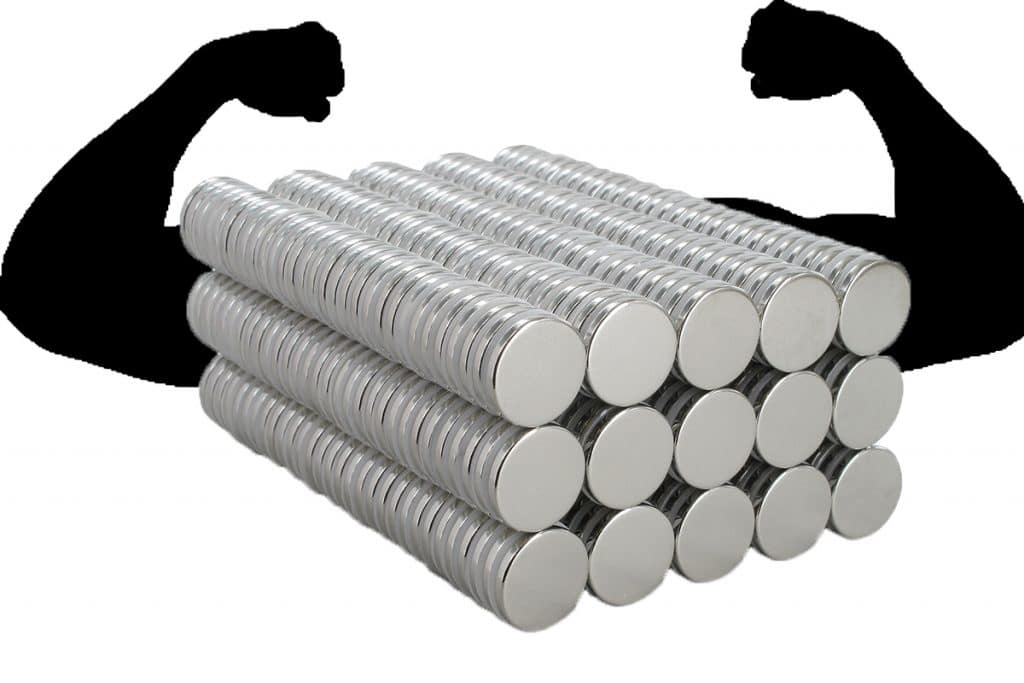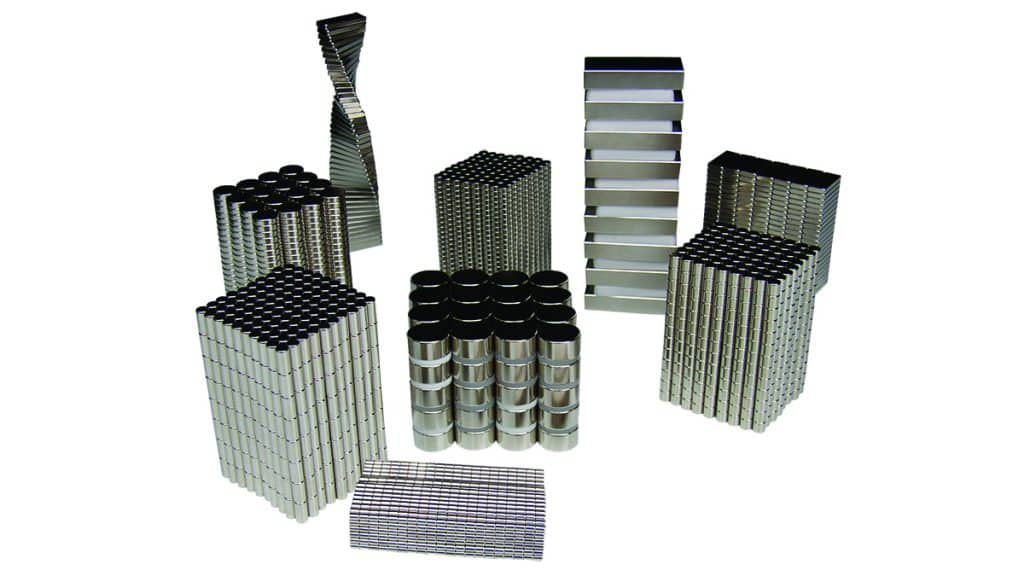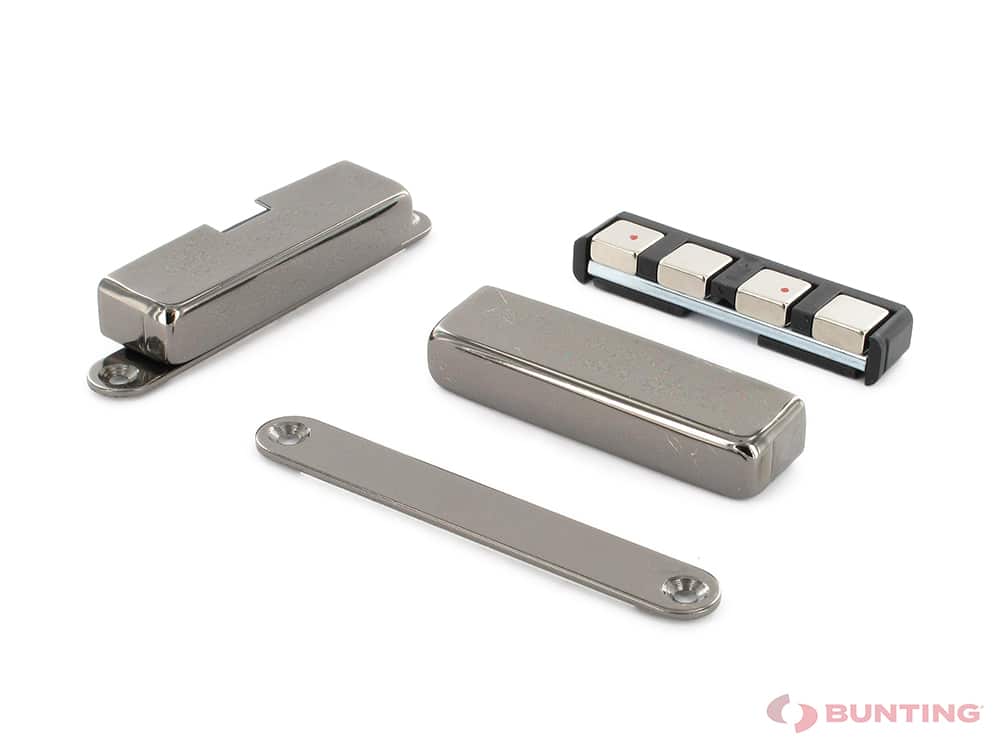Explaining Neodymium Magnet Strength
By Paul Fears | 03 November 2020
Neodymium Rare Earth Magnets are the strongest commercially available permanent magnets in the world. Originally invented by General Motors and Sumitomo Special Metals in the early 1980s, Neodymium Magnets are a key component in mobile phones, computers, wind turbines, and modern cars. The list of applications is nearly endless.

As the name suggests, the prime material in these permanent magnets is the rare earth element Neodymium. The finished magnet is a sintered or bonded alloy of Neodymium, Iron and Boron (NdFeB), forming the Nd2Fe14B tetragonal crystalline structure. The correct composition produces a permanent magnet with exceptionally strong magnetic properties.
Neodymium Magnets – Unique Magnetic Properties
Magnetic properties define the characteristics of any magnet material. They provide the basis for magnet comparison and selection for specific applications. Three key magnetic properties include Remanence, Coercivity, and the (Maximum) Energy Product.
- Remanence (B) – this measures the magnetic field’s strength. Neodymium Magnets have high remanence, meaning their magnetic field has a very high strength.
- Coercivity (Hci) – this is the material’s resistance to demagnetisation. Neodymium Magnets have a high coercivity, which means they are very resistant to becoming demagnetized
- (Maximum) Energy product (BHmax) – this is the density of a permanent magnet’s magnetic energy and is characterized by the maximum value of magnetic flux density (B) multiplied by the magnetic field strength (H). Neodymium magnets have a very high-energy product.

In essence, the combination of the key magnetic properties of a Neodymium Magnet makes it a very versatile and exceptionally strong permanent magnet. Indeed, whereas the maximum energy product of a sintered neodymium magnet ranges from 200 to 400kJ/m3, an Alnico (or ceramic) magnet has a maximum energy product ranging from just 10-88 kJ/m3. This additional power and performance significantly expands the number of applications, with many new technological developments entirely based on the power of the Neodymium Magnet.
Source of Strength
Magnetic Dipole Moment
The Magnetic Dipole Moment is the component of the magnetic moment represented by an equivalent magnetic dipole: a magnetic north and south pole separated by a very small distance. The neodymium atom can have a large magnetic dipole moment due to the presence of four unpaired electrons in the electron structure. On average, iron has three. In a magnet, the unpaired electrons generate the magnetic field, aligned so they spin in the same direction. This structure gives the Nd2Fe14B compound a high saturation magnetisation (Js ≈ 1.6 T or 16 kG) and a remnant magnetisation of typically 1.3 Teslas. Therefore, as the maximum energy density is proportional to Js2, this magnetic phase has the potential for storing large amounts of magnetic energy (BHmax ≈ 512 kJ/m3 or 64 MG·Oe). This magnetic energy value is about 18 times greater than standard-strength ferrite magnets by volume and 12 times by mass. This magnetic energy property is higher in NdFeB alloys than in samarium cobalt (SmCo) magnets, which were the first type of commercialised rare-earth magnet. In practice, the magnetic properties of neodymium magnets depend on the alloy composition, microstructure, and manufacturing technique employed;
- Magnet Comparison: Neodymium and Samarium Cobalt Rare Earth Magnets
Advantages of High Energy Density Neodymium Magnets
As a consequence of the source of magnetic power, high-strength neodymium magnets have many advantages over other types of magnets, such as samarium cobalt and ceramic ferrite. These include:
- Neodymium magnets deliver a greater amount of energy potential in the same volume, providing the same energy potential in a smaller package. This makes neodymium magnets ideal for use in applications such as magnetic sensors and switches;
- When used on a large scale, neodymium magnets are ideal for applications such as magnetic separation, where magnets must be powerful enough to pull out even the smallest particles of ferrous metal contamination from material such as food and plastics particles. The equivalent Ferrite versions would be 20 times larger and, whilst the magnets would be cheaper, the structure needed to house the ferrite would be huge and expensive to build and install;
- Neodymium magnets are also used extensively in the home in such everyday devices such as cabinet magnetic catches because their high energy density allows for small and discrete catches that do not affect the aesthetics of high end installations;
The intense power of neodymium magnets is a driving force in technology and innovation. Our design engineers work closely with customers on projects requiring magnets, identifying the optimum magnet for any given application.
Bunting designs and manufactures a wide range of magnets and magnetic assemblies. Many are bespoke for specific applications. For further information on bespoke magnet assemblies and magnet designs, please contact us via:
Phone: +44 (0) 1442 875081
Email: sales.berkhamsted@buntingmagnetics.com
Via Bunting-eMagnets for online purchase of Magnets and Magnetic Technology




